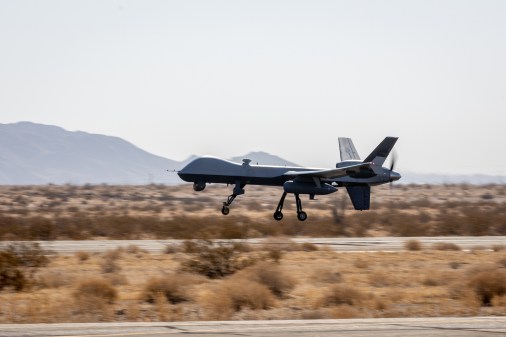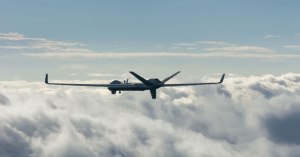Marine Corps wants to mount high-performance computer on Reaper drones

The Marines are searching for a high-performance computer that could be deployed on MQ-9 Reaper drones with authorization to operate at the top secret/sensitive compartmented information (TS/SCI) level.
The release of a sources-sought notice Wednesday is the latest signal by the service that it wants to enhance the capabilities of the largest drone in its arsenal.
The Corps is acquiring MQ-9 long-endurance unmanned aerial systems built by General Atomics to provide intelligence, surveillance and reconnaissance capabilities and to serve as a secure communications gateway and network bridge for the joint force. Officials envision the platforms exchanging data with satellites, other drones and aircraft, ships, expeditionary advanced bases, land maneuver forces, ground control stations and land-based sensors. The effort is expected to contribute to the U.S. military’s warfighting construct known as Combined Joint All-Domain Command and Control (CJADC2).
“If you’re going to be out-sticked by the adversary, then in terms of sensing and in terms of striking, you’re of no value. You have to be able to sense at range, you have to be able to make sense of what’s happening, and you have to be able to share that data ubiquitously across the battlespace with the joint force, which is why our MQ-9 is so important,” Marine Commandant Gen. Eric Smith said at a Brookings Institution event in July.
On Wednesday, the tactical unmanned aerial systems program office (PMA-266) put out an RFI seeking industry input to identify potential solutions for a high-performance computer (HPC) to deploy on the Reaper.
“Ideally, the system, as delivered, should be ruggedized and ready to use with minimal logistics, training, and support. The system should meet the requirements to obtain an Authorization to Operate (ATO) at the Top Secret / Sensitive Compartmented Information (TS/SCI) level. The HPC will be installed in the Centerline Avionics Bay (CAB), mounted underneath the midsection of the fuselage,” officials wrote.
Desired characteristics include a data read/write speed of 16 gigabytes per second; communications interfaces (both internal and external) to support a data transfer rate of 100 gigabytes per second; a maximum length, width, height and weight of 20 inches, 10 inches, 8 inches and 55 pounds, respectively; and a slew of other attributes related to power consumption, environmental considerations and security features.
The Corps wants a system at technology readiness level 7 or higher that can support a variety of software packages including Red Hat Enterprise Linux, PyTorch, YOLO, TensorFlow, and other open-source AI and machine learning tools, the RFI noted.
“One of the most important requirements to meet will be the security classification requirements,” officials wrote, acknowledging that those might be the most difficult for contractors to meet.
“We expect to need a Cross-Domain-Solution (CDS) and a High Assurance Internet Protocol Encryptor (HAIPE) in conjunction with the HPC. Ideally, those would be embedded into the HPC enclosure but may sit outside,” they added.
Responses to the RFI are due by Nov. 24.
The Reapers that the Marines have been acquiring are 36 feet long with a 66-foot wing span, have up to 27 hours of endurance, can fly at an altitude of 50,000 feet, have a payload capacity of 3,000 pounds external and 850 pounds internal, and can fly at a true air speed of 240 knots, according to slides presented at the Modern Day Marine conference in May.
Increment one for the Corps’ so-called MUX MALE initiative is expected to include 20 MQ-9A Block 5 systems plus associated ground control stations and Sky Tower data networking and comms relay pods. At least a dozen of the drones have already been fielded.
In addition to a new high-performance computer that could be mounted on the Reaper, the service is also looking to make the uncrewed systems more difficult to detect by equipping them with a secretive high-tech pod that can counter enemy sensors.
“Some of the pods that go on our MQ-9s are classified … [so] I’ll be careful here,” Smith said in July at the Brookings Institution event, explaining that there’s a type of pod that “can mimic things that are sent to it that it detects, turn it around and send it back. So it becomes a hole, it becomes a black hole, it becomes mostly undetectable.”
DefenseScoop asked Smith if he was referring to an electronic decoy capability that makes it harder for adversaries to locate the drones.
“On the MQ-9 … without crossing classifications levels [in a public forum], it has the ability to somewhat disappear off of an enemy radar. I’ll just leave it at that,” he replied.





